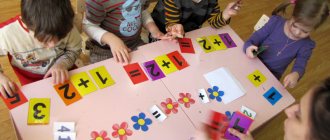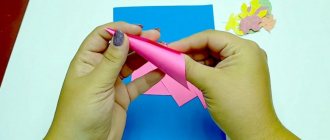Didactic games (DI) are one of the frequently used methods of educational work in preschool institutions. Learning through the process ideally matches the psychological and physiological characteristics of preschool children. It is this period of time that is considered ideal for the development of memory, speech, thinking, imagination, as well as broadening one’s horizons. Thanks to didactic games, you can intensify and diversify the educational impact on the child. At the same time, the organization and conduct of tasks has a number of features that must be taken into account in order to achieve maximum results.
The importance of didactic games in the senior group of kindergarten
DI is used for the purposes of teaching and raising children. With their help, specific learning tasks are solved, and certain skills are nurtured and developed.
DI in the older group
Didactic games for preschool age in preschool educational institutions
The purpose and objectives of the didactic game in the senior group of preschool educational institutions
Making the learning process interesting, simple and non-tiring is the main goal of such classes. The tasks of the didactic game for the senior group of preschool educational institutions are varied. They primarily depend on the requirements of the program and educational field, as well as on how children perceive the material.
If students quickly master knowledge and successfully master the material, then when repeated, the tasks expand.
Note! Otherwise, if children do not master the material well, then the gameplay is carried out with the same software tasks, and their content changes.
DI tasks are inextricably linked to the topic. All material is divided into thematic blocks. Work on one topic lasts from several weeks to one month. Therefore, in one year, many training sessions on various topics are conducted with children and the entire volume of tasks provided for in the program is completed.
DI tasks
Note! In older groups of preschool educational institutions, puzzles, charades, rebuses and intellectual tasks are useful, as they stimulate thought processes and teach children to think creatively and outside the box.
The educational role of games in older preschool age
From early childhood, play has a positive impact on children. As for older preschool age, during this period of time such activities cultivate the following qualities in the child:
- The ability to accept both victory and defeat with dignity.
- A sense of community and camaraderie.
- Honesty.
- Mutual respect.
- Decency.
- Partnerships.
In the senior group of the kindergarten, various games are played; the emphasis is primarily on educational games, as the children are prepared for school.
Preparatory group
In the preparatory group, preschoolers prepare for the transition to first grade and acquire important knowledge and skills. Therefore, complex didactic games with a predominantly educational focus are applicable.
Train for animals
To play, make a cardboard train with 3 carriages: the first for animals, the second for birds, the third for insects. Print out pictures depicting fauna representatives. The game task is to correctly arrange the pictures into the cars.
Man or nature
Children stand in a circle. Throw a ball to each of them in turn, asking at random, “What did the person do?” or “What has nature done?” In the first case, the answers will be, for example, “car”, “clothes”. And in the second there is “tree”, “river”, “stone”, “nest”. The player who finds it difficult to answer is eliminated from the circle. The winner is the last one to give the correct answer.
Name the plant
Say a sound and the players must remember the plants that start with it. For example: A – aster, watermelon, orange, pineapple, aloe, acacia, cherry plum.
Clouds
On a fine day, when cumulus clouds float in the sky, take the students for a walk. Let everyone choose a cloud and tell them what it reminds them of.
Basic approaches to the classification of didactic games in the senior group
DIs are classified according to various criteria. They are divided by:
- the nature of the pedagogical process;
- game technique;
- gaming environment.
Note! Despite the different approaches to classification, every teacher needs to remember that play is not just a child’s activity. It is primarily expressed in the attitude and behavior of adults and is recurrent and permanent in nature.
Contents and selection of materials for the game
DI can be used both in relevant classes and outside educational activities. Depending on where the game is used, its duration is determined.
Preparing for DI
Class structure:
- First of all, a didactic task is determined, which is presented in the form of a game task and set by the teacher.
- Game actions are determined. The older group of kindergarten can independently determine their circle.
- Rules are set. Most often, the teacher sets them, but if the students come up with their own, the teacher can accept them.
- The result of the game is determined.
All didactic games include the main stages:
- the topic and content are communicated;
- participants get acquainted with the game material;
- familiarization with the rules is carried out;
- game actions are performed;
- the results are summed up.
Note! If something in the game did not work out for the child, then after summing up the results, the teacher can continue a personal discussion and analysis of mistakes in each specific case.
In conclusion, the teacher must motivate the students to achieve success in the future.
The role of the teacher in organizing classes
In the process of organizing and conducting didactic games, it is the teacher who must lead the entire process. He is obliged to ensure the direct and active participation of each child.
The role of the educator in the organization of DI
The teacher must think through and organize the entire process in such a way as to ensure that the game is connected with the learning and other activities of the students. Create conditions so that the process turns into an independent activity for children.
Note! The teacher needs to interest children in games. This can only be achieved if there is a sufficient amount of teaching material and toys. At the end of the game, the teacher must give not only an impartial, but also a friendly assessment.
Objectives of didactic games and toys
The main objectives of using educational games and educational toys in teaching young children:
Too lazy to read?
specialists and get an answer in 15 minutes!
Ask a question
- Enrich your child's sensory experience by promoting perceptual development.
- Development of logical thinking, memory, observation, ability to express one’s feelings and thoughts.
- Sensory development.
- Nurture discipline, correctness, honesty, order and strong-willed qualities of the child’s personality, observing the rules of the game.
- Formation of moral concepts and ideas, assimilation of generally accepted norms and rules.
- Education of aesthetic feelings.
Didactic games as a method of teaching young children have their own specific structure:
- Orientation: the child knows the theme of the game, its rules, general course and content.
- Preparing for the game: distribution of roles, familiarization with game actions, consideration of current procedural tasks.
- Direct play: children play independently, the teacher only observes the progress of the game and, if necessary, helps, corrects or guides.
- Discussion of the game: Analysis of the game is carried out in the form of discussion.
In educational games, in addition to didactic material, educational toys are often used. Various cones, turrets, pyramids, spheres, mosaics, etc. are used as educational toys.
How didactic games are conducted in the senior group
In the senior group, conducting a didactic game will lead to the expected results only if all the requirements of the Federal State Educational Standard and educational programs are taken into account. Guided by all these documents, the teacher must be convinced that the process will bring benefit to the children. At the same time, a developmental activity should not only become a form of mastering certain skills and knowledge, but also contribute to the overall development of children.
Developmental and educational value of the game
When it comes to older preschoolers, during the learning process the teacher must not only give children ready-made information, but also gradually complicate it, awakening in them the desire to learn new things and stimulate their cognitive activity.
Values of the didactic game
Important! To make it interesting for children, the game must contain a riddle, a mystery that the children will eventually have to solve.
Visual techniques
If a teacher uses visual aids in an educational game, then he must pay attention to the following nuances:
- The material should be selected taking into account its realism and scientific character. When it comes to objects, professions or phenomena, their image should be presented as realistically as possible.
- It is inappropriate to use fairy-tale and cartoon characters in the game.
- It is not recommended to unnecessarily overload the study process with material. It is necessary to put the preschooler in situations where he has to think and make decisions without relying on visual evidence.
Degree of independence of pupils
Every year the share of children's independence in didactic games is growing rapidly. At the very beginning, the teacher must make sure that the students understand the rules, and only after that invite them to play independently.
If in the process children themselves create their own rules based on existing ones, then the teacher should encourage such activity, since in most cases such a manifestation is worthy of attention and development.
Matching the game to the age of the children
Children in the older group of kindergarten are more attentive and diligent than the younger ones. They are already able to reflect, based on their experience, reason and think about their own actions. Therefore, the content and topics of classes for development are significantly expanded.
Note! Game processes that require a set amount of effort are interesting and age-appropriate for older preschoolers. They build determination and self-confidence in children.
Lapbook “Toys”. Didactic games for primary preschool age
Yulia Sochilova
“Toys” Lapbook. Educational games for preschoolers
Lapbook. Toys. (for younger children)
This laptop can be used to introduce toys on the topic “Toys”, you can repeat the topic “Toys”. Lapbook is inert in working with children in groups and individually, as well as in relation to lessons in the evening, outside of lessons, parents can consolidate their knowledge on the topic of toys together with their children. This laptop includes a variety of educational games: 1 One-Many Educational Game. Goal: to develop the ability to distinguish between the number of objects, many and one.
.2, didactic game Dress the doll Purpose: to teach children to choose and name suitable clothes (for girls. For boys to develop aesthetic taste.
.3 didactic game The fourth extra object Purpose: to strengthen in young children the ability to find the fourth extra object and explain why the object is extra.
.4 didactic game Circle and color Purpose: To develop fine motor skills, a sense of color, perseverance, and accuracy in young children.
.
.5 educational game Find my shadow Purpose: to teach young children to find given silhouettes of objects, animals, toys; develop children's visual perception, attention, and observation skills.
.
.6 didactic game Dress up the matryoshka Purpose: to teach young children to memorize geometric shapes (circle, square, rectangle, triangle, teach to group objects by color, correlate geometric shapes by shape by overlapping.
.7 educational game Cropped pictures Purpose: to teach young children to form a whole consisting of two parts, to develop logical thinking, visual perception, and attention.
What else to read: Environmental education of preschoolers through play
.8 educational game Consider and color Goal: to develop visual perception in young children, the ability to guess and name a toy, choose the color of a pencil for coloring a toy, the ability to hold a pencil correctly, develop fine motor skills, develop accuracy and consistency,
.
.
.9 didactic game with lacing My toys Purpose: to teach young children to correctly name a toy according to its external characteristics according to poems read by adults in order to make up a story about this toy (why do you need such a toy, like plays with it, the one who plays with it, develops and replenishes vocabulary, finds the necessary parts of the toy and connects with a rope, develops fine motor skills.
educational game .ten Collect a picture Purpose: To introduce young children to a variety of toys, do exercises on creating pictures from geometric shapes (you can use a constructor)
develop sensory perception of fine motor skills of the hands.
Types of didactic games in the senior group of kindergarten
Didactic games in the senior group are divided into several varieties.
Types of didactic games
They are distinguished by the following criteria:
- educational content;
- cognitive activity;
- game actions and rules;
- children's organizations;
- role of the teacher.
The listed differences are inherent in all didactic games, but they appear more clearly in some than in others. Games are also classified:
- on sensory education;
- to get acquainted with nature and the surrounding world;
- on the formation of mathematical concepts;
- verbal;
- musical;
- on literacy preparation;
- figurative;
- with educational toys;
- pseudo-plot;
- desktop-printed.
By type of activity, game processes are as follows:
- trips;
- instructions;
- offers;
- puzzles;
- conversations or dialogues.
Note! The classification does not end there. The entire range of possible gaming techniques is huge. But as practice shows, the ones listed above are most often used.
Card index of educational games in the senior group of preschool educational institutions with goals according to the Federal State Educational Standard
Important! Modern kindergartens carry out their activities in accordance with the standards of the Federal State Educational Standard. When developing a thematic plan, each educator must take into account and implement learning activities in accordance with the requirements of the standard.
DI card index
Examples of didactic games in the senior group
All didactic game processes are specially developed by teachers for teaching children. The main goal is to combine business with pleasure. While playing, a child learns and develops certain skills. Now you can find a huge number of didactic games for children in the senior group of kindergarten on the Internet. You can print them out and offer them to children.
The most common of them are the following:
- “Good or bad” - the essence is that several life situations are reproduced, and the child must express his opinion and attitude. Develops speech, attention and memory.
- “Seasons” - 4 pictures depict the seasons. There are also cut cards with their signs. In the process, the child must correctly identify the signs of winter, spring, summer and autumn, and also arrange the cards in their places.
- “We teach the months of the year” - the child must know in what sequence the months of the year are distributed, and be able to determine, for example, that after December comes January, and after February comes March.
- “Search for objects in the picture” - helps develop children's memory while playing.
Note! A didactic game for a teacher is one of the most effective methods of achieving educational goals.
Children of the older group enjoy completing assigned tasks in the process, while developing certain skills and abilities for subsequent socialization.
Didactic games for preschoolers 3 - 5 years old
Formation of spatial orientations in children 4 years of age
Educational games for children 3-5 years old Author: Maria Viktorovna Komova, teacher of secondary school No. 1912, Moscow, Zelenograd Description of the material: The material will be of interest to teachers working with younger preschoolers, as well as to parents raising children 3-5 years old. Games are used both in direct educational activities and in free time, while walking. Goal: To develop the ability to navigate in space in children of primary preschool age. Objectives: teach children to distinguish and name parts of the body, face, distinguish between right and left hands, navigate in the directions bottom-up, back-to-front, left-right, activate some “spatial” prepositions in their speech (under, instead of, with, about , near). 1. Game “What has changed?” Purpose: to show that spatial relationships between objects can be replaced: an object that was above can be below, and vice versa. The game uses a set of toys and a ladder. On the top step, the toys are lined up one after another. First, with the children, we find out who is next to whom, then we change the position of the toys. Children answer the teacher’s questions: “What has changed?” Questions for children: who is below, above, next to? Who is to the right of the duckling? Who's to the left of the rabbit?
What else to read: Aesthetics in kindergarten
Children were asked to close their eyes
What changed? “The bunny jumped off the ladder” (Borya)
2. Game activity “Where was the bear looking for the ball?” The bear's area of action is limited. Educational material - furniture for dolls (table, chairs, sofa, bed, wardrobe, bedside table), life-size doll - bear and ball. Program content: to attract children's attention to various options for spatial relationships between objects. Activate some “spatial” prepositions in their speech (under, instead of, with, approximately, next to) ... Teach children to change the endings of names when using various prepositions (on a chair, under a chair, near a chair, etc.: Bear comes to visit the children.
The teacher tells the children that the bear wants to play with the ball, but the ball rolled somewhere. The search for the ball begins. The teddy bear looks under the reading, under the table, under the wardrobe, under the sofa, under the chair, looking for a ball for the sofa, for the closet, he looks inside v closet e v bedside table; Then he goes to the closet and finally finds the ball in the trash can. While looking for the ball, the teacher talks to the children. Asks questions: “Where is the bear going now?”, “What is he doing?” Corrects inaccuracies in children's speech, invites everyone to tell together where the bear is looking for the ball.
Then the children were asked to play hide and seek with a teddy bear: “Now you yourself will hide the toys in different parts of the room. And the bear will watch. Think about where you would like to hide the howling toy." The teacher invites everyone to tell where they want to hide their toy, and then hide it. The toys are hidden, the bear begins to search. Children carefully watch his actions, and I will be happy to answer questions about where he found the toy. 3. Game-activity “Find a toy.” In the absence of children, the teacher hides toys in places accessible to children in the group room and offers to find them. “Everyone will find only one toy. Make sure you remember where you find your toy and then tell all the kids about it." Children begin to look for hidden toys with interest. When the toys are found, the teacher asks the children to tell where they were hidden. Another version of the game. One of the children closes his eyes, the others hide the toy on the table, under the table, on the closet. At a signal, the child opens his eyes and begins to look for the toy. Having discovered it, he explains where the toy was. 4. “Where are your hands?” Task: hide your hands behind your back. The teacher first guesses where the child’s right hand is and where the left is, then invites one (or several children) to show their hands and name them. 5. “Where is the toy?” Task: hide the toy in the palm of your hand. The teacher’s task is to guess whether he is in the right or left hand. Then invite the children to show their hands one by one: right and left, name them, tell them in which hand the toy is hidden. 6. “Tick the checkbox.” The teacher invites the children to remember what the right (left) hand is and take the flag; transfer the flag to the other hand, raise your hand, wave the flag and move it back to the right. Or: blue flag (ribbon) in the right hand, yellow flag in the left. Task: swap the flags. After this, the teacher asks: “What color is the flag? In which hand? The game “Catch the Flag” was played with children in subgroups
What else to read: Summer camp games. Ecological game "Chamomile"
We greet with the left hand, and now with the right
7. “Move the chestnuts to your other hand.” Several chestnuts (5-6) need to be transferred one at a time from one hand to the other. During the exercise, the child shapes his hands and labels them. At the same time, the concepts of “one” and “many” are reinforced in children.
Role-play situations to maintain interest in classes and create a positive emotional mood. Purpose: to delineate the spatial arrangement of body parts (arms, legs, eyes, ears). Material: life-size “Bear” doll; red, blue circles depending on the number of children in the group. Lesson Course: Guys, do you hear someone knocking on our door? Let's see who's there? Mishka came to visit us. He wants to see how we take care of you. Children are sitting on the carpet. Guys, please show me your right hand, and now your left. Nadya, show your right hand, Nikita - your left... Take a red circle in your right hand, raise your hand and show the circle to Mishka. Now take the blue circle in your left hand. Show the circle to Mishka. The bear wants to ask Seryozha what he is holding in his right hand. In which hand is Dima holding the blue circle? Now let's play. The boys keep a short distance from each other. Put your hands down. Now raise your right hand up and your left hand down. Now stretch your arms forward, raise your right arm to the right, your left arm to the left, lower your arms. Touch your right knee with your right hand and touch your left knee with your left. Pat yourself on the knee. Very good! Now we are sailing on a ship and decided to look through a telescope. The tube was first attached to the right eye and then to the left eye. Pinocchio heard a rustling in the toilet. He listened, placing his hand first on his right ear and then on his left. Now let's become storks. Raise your right leg and stand on your left. “A stork walks through a swamp, a stork is looking for a hippopotamus.” Let's change legs, now stand on the right leg and raise the left.
We recommend watching:
Sensory educational game for kindergarten Fun games for kindergarten Family work game Fun game for middle age children







